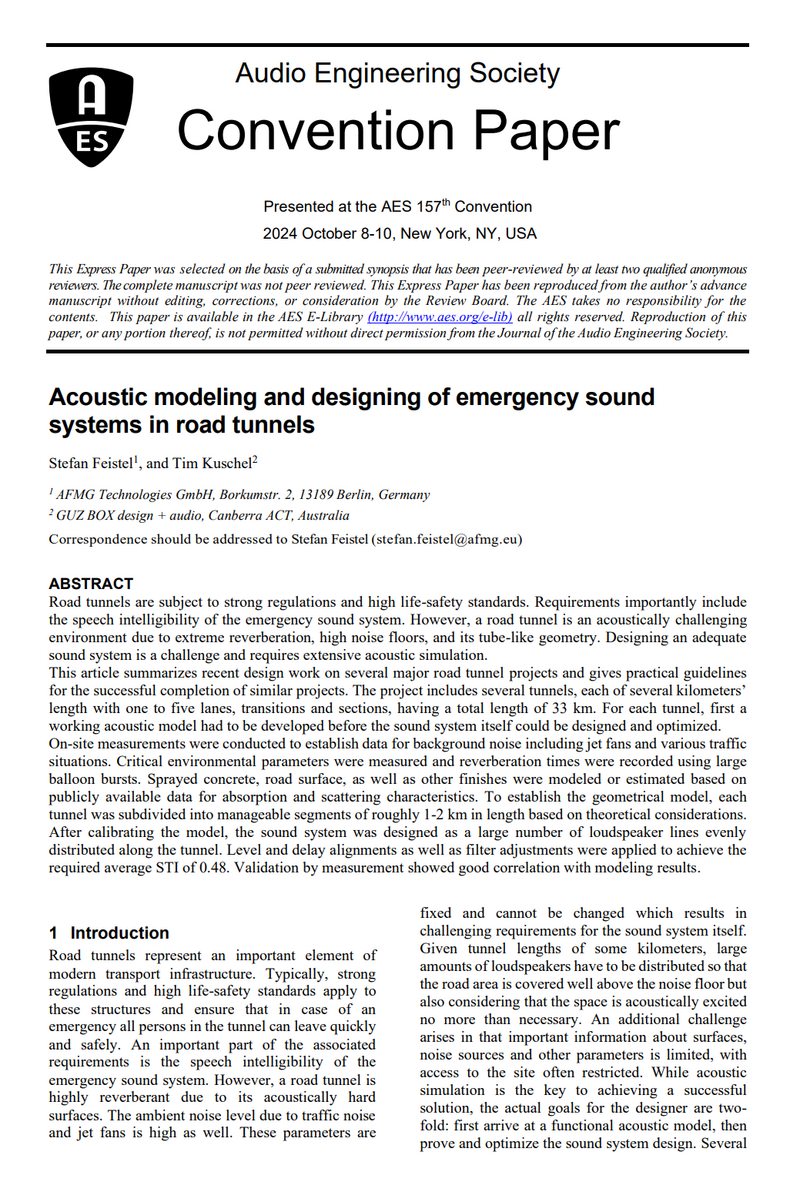Acoustic modeling and designing of emergency sound systems in road tunnels (Paper)
"Acoustic modeling and designing of emergency sound systems in road tunnels", paper presented at the 157th AES convention, New York, NY, USA 8-10th of October 2024.
Link to the paper in the AES Online E-Library. (You have to be a member of the AES online library. Please note that subscription costs are low.)
Stefan Feistel
AFMG Technologies GmbH, Berlin, Germany
Tim Kuschel
GUZ BOX design + audio, Canberra ACT, Australia
Abstract
Road tunnels are subject to strong regulations and high life-safety standards. Requirements importantly include the speech intelligibility of the emergency sound system. However, a road tunnel is an acoustically challenging environment due to extreme reverberation, high noise floors, and its tube-like geometry. Designing an adequate sound system is a challenge and requires extensive acoustic simulation.
This article summarizes recent design work on several major road tunnel projects and gives practical guidelines for the successful completion of similar projects. The project includes several tunnels, each of several kilometers’ length with one to five lanes, transitions and sections, having a total length of 33 km. For each tunnel, first a working acoustic model had to be developed before the sound system itself could be designed and optimized. On-site measurements were conducted to establish data for background noise including jet fans and various traffic situations. Critical environmental parameters were measured and reverberation times were recorded using large balloon bursts. Sprayed concrete, road surface, as well as other finishes were modeled or estimated based on publicly available data for absorption and scattering characteristics. To establish the geometrical model, each tunnel was subdivided into manageable segments of roughly 1-2 km in length based on theoretical considerations.
After calibrating the model, the sound system was designed as a large number of loudspeaker lines evenly distributed along the tunnel. Level and delay alignments as well as filter adjustments were applied to achieve the required average STI of 0.48. Validation by measurement showed good correlation with modeling results.
Practical benefits:
The paper can serve as a guide for the design of emergency sound systems in any road tunnel. It shows the main challenges and a number of practical solutions for acoustic design aimed at delivering clear evacuation messages under conditions of high noise levels from tunnel jet fans, traffic, active deluge systems and conditions of highly reflective surrounding surfaces. The paper also demonstrates how 3D acoustic models of large projects, up to tens of kilometers in length, can be broken down into sections without compromising the accuracy of the results, and how different AFMG products such as EASE 5, AFMG Reflex, AFMG SoundFlow can work together to achieve the common goal.
